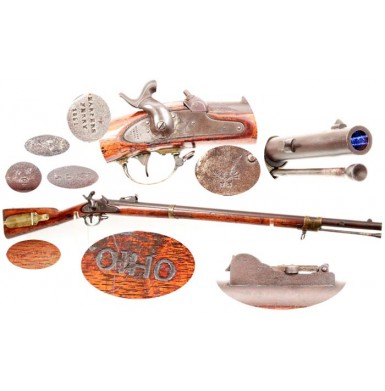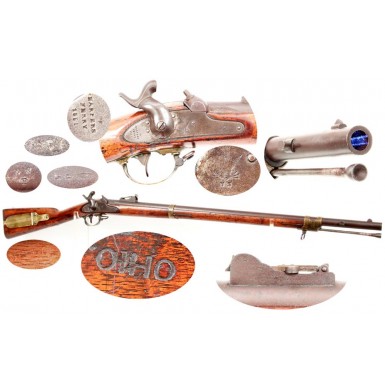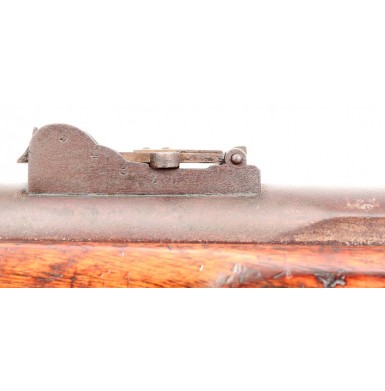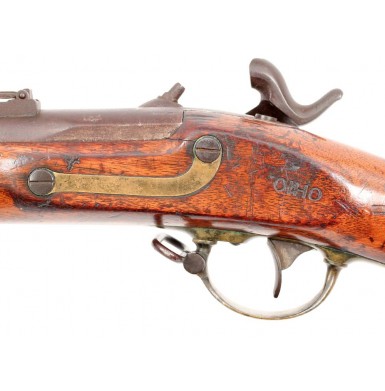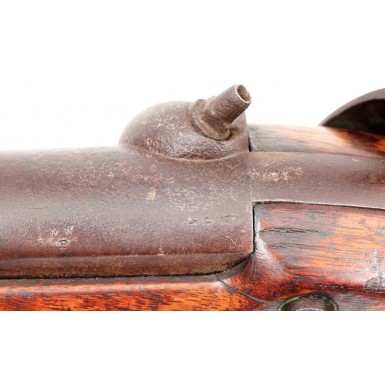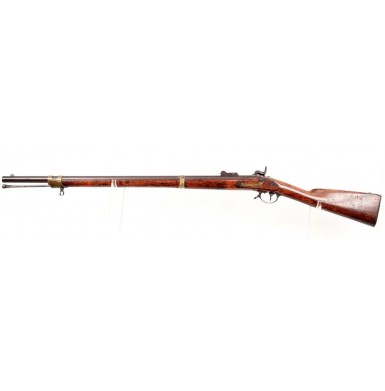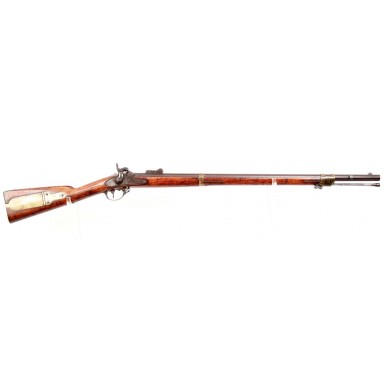Harpers Ferry Type III Mississippi Rifle Alteration
- Product Code: FLA-2858-SOLD
- Availability: Out Of Stock
-
$1.00
This is a really nice condition example of the US M-1841 Mississippi Rifle as produced at the National Armory at Harpers Ferry. During the production run at Harpers Ferry from 1844 to 1855, the armory produced 25,296 of the rifles, while an additional 66,500 were produced by a variety of contractors for the US government. The M-1841 was the first percussion ignition long arm adopted by the US military. It was also the first large-scale production long arm to be manufactured with interchangeable parts by a National Armory. While the M-1819 Hall breech loading flintlock rifle (as produced at the rifle works at Harper’s Ferry) was also an interchangeable parts weapon, it was produced in limited quantities and was not intended for the level of widespread issue that the M-1841 was destined for. As originally designed, the M-1841 was a .54 caliber rifle intended to fire a patched round ball and was equipped with a fixed rear sight and had no provision for a bayonet. Under Secretary of War Jefferson Davis (who served in that capacity during the administration of President Franklin Pierce from 1853-1857), the national armories were tasked with the job of modernizing US military small arms and munitions. Davis had direct personal experience with the effectiveness of the M-1841 rifle from his command of forces armed with that rifle during the Mexican American War, and felt that arming all of the US military with rifled arms would put the army at a distinct advantage compared to armies that still relied upon smoothbore muskets. During the early 1850s Harpers Ferry started experimenting with a variety of modifications to the M-1841 rifle to make it a more modern and useful weapon. During these experimentations, a variety of adjustable rear sights and bayonet lug configurations were tried, in an attempt to find the best possible improvements for the rifle. These series of experiments, with the additional modification of adding the Maynard automatic tape priming system, eventually resulted in what would be the replacement for the M-1841 rifle; the M-1855 rifle. During the modification and testing process, small quantities of rifles (typically in lots of roughly 500-1000) were modified and sent into the field for use and trials. Many of these guns remained in their original .54 caliber, and were simply platforms to test different patterns of rear sights and saber bayonet systems. After the adoption of the M-1855 family of arms, and the adoption of .58 caliber as the standard military caliber, many of the guns were re-bored and re-rifled for the use .58 elongated ball ammunition and were provided with all iron ramrods designed for use with conical balls. It is believed that all of the M-1841s produced during the final year of production at Harpers Ferry were produced in .58 caliber. The rifles that were modified at Harpers Ferry were pulled from existing stocks of arms in storage there, and were typically reassembled without any regard to the origin of the parts. Since the rifles were interchangeable, there was no need to mark barrels, locks and stocks to keep the original components together. As such, mismatched lock and barrel dates are the rule, rather than the exception on these armory altered arms. Arms researchers and collectors differ on what terminology to use in the description of these altered “Mississippi” rifles (Type I, Type II, etc.), but at least five patterns of rear sight and three styles of saber bayonet attachment were experimented with, and extant examples of nearly every possible combination exist in both .54 and .58 caliber.
This particular example of a experimental, Harpers Ferry altered US M-1841 Mississippi Rifle is in VERY GOOD+ to NEAR FINE condition. The gun is categorized as a Type III alteration by George Moller in American Military Shoulder Arms. These guns were produced during fiscal years 1856, 1857, 1858 and 1859. The rifles utilized the newly adopted US M-1855 rifle pattern long-range rear sight and the M-1855 rifle saber bayonet lug. Moller notes that some of the 1,050 rifles altered in fiscal year 1856 were of this configuration and remained in .54 caliber. Of the 945 altered in fiscal year 1857, 803 were re-bored to .58 and the remaining 142 were left in their original .54 caliber. Of the 1,663 rifles altered in fiscal year 1858, it is believed that all of the guns were left in their original .54 caliber. Of the 1,904 rifles altered in fiscal year 1859, 1,062 were re-bored to .58 and the remaining 842 were left in their original .54 caliber.
The gun is 100% complete and correct in every way, with exception of what appears to be a period replaced iron ramrod. This is one of the guns that retains its original .54 bore, with 7-groove, rapid twist rifling for use with patched round balls. The rifle has a standard long base, adjustable ladder rear sight, of the same pattern found on early production US M-1855 rifles and rifle muskets. The sight is attached to the barrel via a dovetailed notch and a spanner screw. The gun has had a saber bayonet lug without a key dovetailed into the right hand side of the barrel, near the muzzle. The rear sight, iron front sight and bayonet lug configuration are all the same pattern as used concurrently on the “Brass Mounted” US M-1855 rifles. In order to fit the rifle with a lug mounted saber bayonet, the forend of the rifle had to be shortened slightly, and the brass nose cap had to be replaced with a new, shorter one. While these Harpers Ferry altered rifles normally show mixed dates, this one does not. The lock is clearly marked in three vertical lines to the rear of the hammer HARPERS / FERRY / 1851 and with a (Spread-Winged Eagle) / U S forward of the hammer. The barrel tang is marked with the date 1851, but is very difficult to read due to pitting in the breech and tang area. The left breech of the rifle is marked with the typical Harpers Ferry inspector marks: WW / P and with a V / P / (Eagle Head). The Harpers Ferry stock bears the usual three router bit pilot holes in the patch box, as well the block inspectors initials J L R. The stock flat opposite the lock probably showed one or two sets block letter inspectors’ initials originally, but has been over-stamped with an OHIO surcharge, which has rendered these inspector marks illegible. As is correct on Harpers Ferry produced Mississippi rifles, there is no US mark on the buttplate. All of the marks in the metal are relatively crisp and legible. The lock has a nice, smooth plum brown patina over most of its surfaces, but the tail of the lock area has been lightly cleaned to make the Harpers Ferry and date mark more visible. The hammer shows the same smooth plum brown patina. The lock is mechanically excellent and functions perfectly on all positions. The barrel is mostly smooth with a smooth plum brown age patina as the lock, mixed with original arsenal brown finish. When the barrel bands are moved, the original arsenal lacquer brown finish is visible on the top of the barrel, and the underside of the barrel, protected by the barrel channel, retains the majority of its original browned finish as well. The barrel retains about 40% of its original brown finish overall (top and bottom), with the exposed surfaces having blended the browned finish with an oxidized brown patina. There is some lightly scattered pinpricking and peppering present along the length of the barrel, along with some small patches of minor surface roughness. The breech area of the rifle shows more moderate pitting, the result of the caustic effect of the mercuric percussion caps of the era. The tang screw hole in the breech plug tang shows some odd wear and chipping around its interior, suggesting that the tang screw may have been stuck in the stock and had to be pried out at some point in time. The tang screw appears original and shows the same age and wear found on the balance of the rifle. The minor damage to the tang hole is mentioned for exactness and is clearly shown in the pictures below. The bore of the rifle rates about GOOD+ to NEAR VERY GOOD. It retains its original deep, 7-groove rifling and is dark and dirty with evenly scattered moderate pitting along its entire length. A good scrubbing with a bore brush might improve the bore to very good or better, and some of the apparent pitting may be accumulated dirt and debris from over the decades. The gun retains both of its original sling swivels, one on the forward triggerguard bow and one on the upper barrel band. The original and correct alteration long-range rear sight is present on the barrel and the arsenal installed iron front sight is present as well. The original saber bayonet lug is present on the rifle as well. As the gun was not altered to .58 and intended to shoot elongated ball (Mini” style) ammunition, the original brass tipped rammer would have been retained during the alteration process at Harpers Ferry. Only those rifles altered to shoot elongated, expanding base ammunition, were provided with the trumpet head, all steel ramrods, after 1855. However, the ramrod that is present is a very old, non-armory pattern, all iron rod with a semi-tulip shaped head and a recessed face. The rod is exactly the correct length for the rifle and is correctly threaded at the end. It strongly resembles the rods used on some of the Mississippi rifle alterations done by Leman, and appears to be an essentially correct period replacement. The brass furniture has a lovely deep ocher patina, with some much darker brownish age discoloration on the patchbox and the triggerguard. The stock of the rifle is really in VERY GOOD condition. The block letter marks remain crisp and legible in the patchbox and the Ohio mark is quite crisp on the flat opposite the lock. The edges and contours of the stock all show some rounding and loss of definition. This appears to be the result of age and use, and maybe an old cleaning, but I don’t think the stock has been sanded. The stock is full length and is free of any breaks or repairs. The stock has a very old coat of varnish that has helped to protect it over the year, but it has also leant an orange tone to the wood. This old coating could be removed if so desired, by a patient and careful wood worker, but I will leave that decision to the new owner.There is a tiny stress grain crack running from the rear lock mounting screw to the barrel channel, the result of the screw being over tightened. As would be expected, there is some minor slivering and wear and long the rammer channel as well. The stock shows a significant number of the typical bumps, dings, gouges and minor marks from handling, use and storage, as would be expected, but shows no abuse or damage at all.
Overall this is a really nice example of a scarce Harpers Ferry US M-1841 Mississippi Rifle, with the Type III Harpers Ferry long range rear sight and bayonet lug alterations. The gun also has the desirable OHIO surcharge, which indicates that the rifle was sent to Ohio circa 1863 with thousands of other 2nd, 3rd & 4th class long arms to compensate the state of Ohio for arms that it had provided to its own early war volunteer infantry regiments. The gun is in very good condition with attractive metal that retains some original brown, good markings, lovely brass with a thick patina, and a nice stock. The gun is a 100% correct Harpers Ferry produced rifle, with the exception of the replace ramrod. This is an important distinction, as Harpers Ferry locks are often found in M-1841 rifles made by other makers, in an attempt to increase the desirability and value of an otherwise less valuable contractor made gun. The gun is mechanically fine and has a decent bore that could well be improved. I have always found the Mississippi Rifle variants with the long-base ladder rear sights and the keyless bayonet lugs to be the most attractive Mississippi variant, and it would be a the perfect addition to any Civil War rifle display, as it was truly the direct predecessor of the M-1855 brass mounted rifles, and was subsequently altered concurrently while the M-1855 was produced. If you have been waiting for a no-excuses, completely correct Harpers Ferry altered Mississippi to add to your collection (without spending $4,500 or more), this would be a great rifle for your collection.
SOLDTags: Harpers, Ferry, Type, III, Mississippi, Rifle, Alteration

